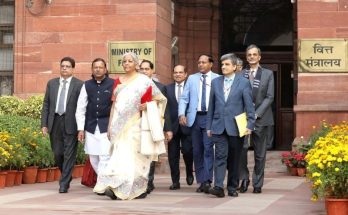By Maheep
#CAA, #CitizenshipAmendmentAct, #Pakistan, #Afghanistan, #Banghladesh
IBNS-CMEDIA: On March 11, 2023, India’s Ministry of Home Affairs (MHA) notified the Citizenship Amendment Rules, 2024.
The notification permitted the implementation of the Citizenship (Amendment) Act (CAA) that was passed by Parliament.
On December 9, 2019, the Lok Sabha (Lower House) passed the Citizenship Amendment Bill (CAB) with an overwhelming majority of 311 votes to 80 votes. Again, on December 11, after a 9-hour-long, intense debate, the Rajya Sabha (Upper House) passed the CAB with 125-105 votes.
As per the notification dated May 28, 2021, the MHA invited applications for citizenship from Sikhs, Hindus, Jains, Christians and Buddhists hailing from Afghanistan, Pakistan and Bangladesh who are currently residing in 13 districts of Gujarat, Rajasthan, Chhattisgarh, Haryana and Punjab.
Most importantly, the option of naturalisation or registration is not available to illegal immigrants. For legal migrants, who want to apply for Indian citizenship, all rules are the same.
The Act actually makes it easier for persecuted minorities of India’s neighbours Pakistan, Bangladesh and Afghanistan to become citizens of India as it entitles Hindus, Sikhs, Buddhists, Jains, Parsis and Christians facing religious persecution in these nations, to seek Indian citizenship.
The religious minorities residing in the above-mentioned countries not only face discrimination, but they are targeted, hounded and killed in broad day light. And most significantly, all these three countries are either Islamic theocracy or with a volatile combination of rudimentary democracy along with strong Islamist principles.
Therefore, CAA becomes more pertinent by the day, for non-Islamic minorities, who are practically living in morbid atmosphere since many decades.
Pakistan
In Pakistan, the overwhelming Muslim majority of 96.28% contrasts starkly with the small Christian population at 1.59% and Hindus at 1.60%.
The Sikh community, once vibrant, faces extinction, with conflicting estimates of their numbers.
While Pakistan’s National Database and Registration Authority (NADRA) claims that there are only 6,146 Sikhs registered in Pakistan, according to an estimate, census conducted by NGO Sikh Resource and Study Centre (SRSC), about 50,000 Sikhs still live in Pakistan.
This discrepancy highlights the challenges in accurately representing minority populations.
The situation of Hindu minorities in Pakistan reveals a distressing narrative marked by inhuman treatment, relentless atrocities, and daunting challenges for survival.
With their population declining drastically from 24% at the time of partition to a mere 1.60% today, Hindus continue to endure egregious discrimination, violence, and systematic oppression that imperil their very existence.
Forced conversions, abductions, and targeted attacks are the grim realities that confront religious minorities in Pakistan. Young Sindhi Hindu girls, aged between 12 and 28, are frequently abducted, forcibly married off, and coerced into converting to Islam.
The reduction in the number of Hindu temples from over 400 at partition to a mere 20 today paints a grim picture of the deliberate destruction and desecration of their religious sites.
This cultural vandalism is not just a physical assault but a symbolic erasure of their heritage and traditions.
The plight of Pakistani Christians is equally distressing.
They endure substandard living conditions and are increasingly targeted by intolerant factions. Pakistan’s blasphemy laws, carrying the threat of death for perceived insults to Islam, have led to egregious injustices.
The case of Asia Bibi, falsely accused of blasphemy, exemplifies the grave risks faced by Christians.
Despite her acquittal after years of legal battles, Asia Bibi had to seek refuge in Canada, underscoring the perilous situation for religious minorities.
International bodies like the US State Department and human rights organizations have raised serious concerns about Pakistan’s treatment of religious minorities.
The US Commission on International Religious Freedom (USCIRF) has highlighted the alarming frequency of forced conversions and marriages, condemning the exploitation of underage girls from minority communities.
Moreover, discriminatory practices in employment and education further marginalize minorities, pushing them into impoverished conditions and limited opportunities. The lack of representation and advocacy exacerbates their vulnerability, leaving them voiceless in the face of relentless persecution.
Afghanistan
In Afghanistan, non-Muslim groups such as Hindus, Sikhs, Baháis and Christians make up less than 0.3% of the population. During the first Taliban regime, militant rulers announced that Sikhs and Hindus would be forced to wear yellow badges for identification, sparking international outrage. Additionally, they were prohibited from constructing new temples and were required to pay jizya, a tax imposed on non-Muslims.
By 2023, the Sikh and Hindu populations in Afghanistan had dwindled to fewer than 100 individuals, despite Taliban assurances of their safety, as reported by the US. This represents a staggering decline from the estimated 60,000 members they had in 1992. The remaining few are primarily concentrated in Nangarhar, Kabul, and Ghazni provinces.
Since the Taliban regained control of Afghanistan in August 2021, Sikhs have faced escalating challenges. In August, the Taliban forcibly removed the Nishan Sahib, a Sikh holy flag, from the GurdwaraThala Sahib in the Chamkani region of Paktia province. Additionally, in June 2022, a Sikh Gurdwara in Kabul was subjected to a fortified attack, resulting in casualties and injuries.
Sikhs and Hindus are subject to stringent restrictions on their outward appearance and are forbidden from publicly observing religious holidays, prompting many to flee the country. While the Taliban have attempted to ease the fears of non-Muslim Afghans by visiting Sikh and Hindu temples and pledging safety, their actions have failed to provide meaningful protection.
The harsh treatment of Sikhs and Hindus under Taliban rule has led to a mass exodus from Afghanistan, with many seeking refuge in India. On the other hand, Afghan Christians, who are mostly converts, are facing increased security threats.
There are reports suggesting that the Taliban have put bounties on capturing Afghan Christians, which has forced this community to practice their faith secretly. Revealing their religious identity in public could put their lives at risk due to the dangers posed by the Taliban.
Despite the Taliban’s denial of the existence of Christians in Afghanistan, international organizations have consistently highlighted Afghanistan’s dismal record on religious freedom, particularly for Christians. Many Afghan Christians have gone into hiding to evade abduction and persecution by Taliban authorities.
Bangladesh
The challenging situation of religious minorities in Bangladesh is a distressing reality marked by persecution, atrocities, and an appalling status quo. Despite Bangladesh’s inception in 1971 with a secular constitution, Islam was officially declared the state religion in 1988, a status reaffirmed by the top court in 2016.
This legal framework has led to a complex environment where religious and ethnic minority communities face severe challenges.
Hindus, Buddhists, Christians, Chakma Tribal, Free Thinkers, and Atheists comprise the marginalized groups enduring discrimination along ethnic and religious lines.
The US State Department has expressed concerns about jihadi and Islamist terrorism in Bangladesh, highlighting the gravity of the situation. Amnesty International’s “Bangladesh 2022” report paints a grim picture, citing instances of violence and persecution.
The death of Indigenous rights Buddhist activist Nabayan Chakma Milon in military custody, the mob attack on a Hindu temple and homes in Narail district, and the exodus of millions of Hindus from Bangladesh depict the widespread plight of minorities. Violence against Hindus has escalated, with thousands of attacks resulting in deaths, injuries, and property damage.
Tribal Christians face a double vulnerability, confronting land disputes and violent acts. The killing of eight tribal Christians in April 2023 underscores the ongoing threat to religious minorities. Christian converts endure social media hate campaigns and personal information exposure, reflecting a broader pattern of intolerance and discrimination.
In Bangladesh, Christians represent a minuscule fraction (.06%) of the population and are often treated as inferior second-class citizens. The targeting of converts and the spread of anti-Christian rhetoric highlight the challenges faced by this marginalized community.
The Citizenship Amendment Act (CAA) in neighboring India offers a potential solution by easing the path to citizenship for persecuted minorities from countries like Bangladesh, providing them with an opportunity to seek refuge and escape religious persecution.
According to data from the Bangladesh Bureau of Statistics and other reports, around 12.5 million Hindus fled from East Pakistan between 1950 and 1971. Additionally, an estimated 15 million Hindus have left Bangladesh between 1974 and 2016, indicating a significant trend of migration due to persecution and insecurity.
In conclusion, The Citizenship Amendment Act (CAA) stands as a beacon of hope for persecuted religious minorities in India’s neighboring states, embodying India’s commitment to humanitarian values and regional stability.
The Act’s implementation, following rigorous parliamentary debates and due process, marks a significant step towards offering refuge and citizenship to communities facing religious persecution in Pakistan, Afghanistan, and Bangladesh.
By addressing the dire plight of minorities in these countries and providing a legal pathway to Indian citizenship, the CAA showcases India’s proactive role in safeguarding human rights and fostering a more inclusive and secure South Asian region.
About the author
Dr. Maheep is a leading analyst of International Relations and Global Politics. He contributes regularly on issues of utmost significance of Humanity.





